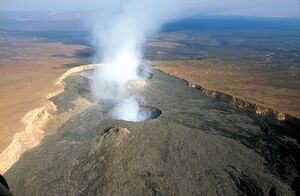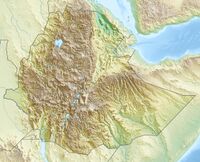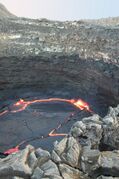Erta Ale
Topic: Earth
 From HandWiki - Reading time: 4 min
From HandWiki - Reading time: 4 min
| Erta Ale | |
|---|---|
 Erta Ale in May 2008 | |
| Highest point | |
| Elevation | 613 m (2,011 ft) [1] |
| Listing | List of volcanoes in Ethiopia |
| Coordinates | [ ⚑ ] : 13°36′23″N 40°39′41″E / 13.60639°N 40.66139°E |
| Geography | |
| Parent range | Erta Ale Range |
| Geology | |
| Mountain type | Shield volcano |
| Last eruption | 2005 to 2020 [2] |
Erta Ale (or Ertale or Irta'ale; /ˈərtə ˈeɪl/ Amharic: ኤርታሌ) is a continuously active basaltic shield volcano in the Afar Region of northeastern Ethiopia, which is itself part of the wider Afar Triangle (a barren desert region straddling Djibouti, Ethiopia and Eritrea). The volcano is located in the Danakil Depression, an area on the border between Ethiopia and Eritrea that is below sea level. It is the most active of the volcanos in Ethiopia.[3]
Geology
Erta Ale is 613 metres (2,011 ft) high, with one or sometimes two active lava lakes at the summit which occasionally overflow on the south side of the volcano.[1] It is notable for holding the longest-existing lava lake, present since the early years of the twentieth century (1906). Volcanoes with lava lakes are very rare: there are only eight in the world.[4]
Erta Ale means "smoking mountain" in the local Afar language and its southernmost pit is known locally as "the gateway to Hell". In 2009, it was mapped by a team from the BBC using three-dimensional laser techniques,[5] in order for the mapping team to maintain a distance and avoid the lakes' searingly hot temperatures.
Erta Ale is centered over the East African Rift system, which is a triple junction setting whose movements are resulting in the formation of a pull-apart basin or rift. The volcano comprises mainly mafic material which has been brought up to the surface caused by unroofing of the mantle due to this rift formation.[citation needed]
There was a major eruption on 25 September 2005 which killed 250 head of livestock and forced thousands of nearby residents to flee.[6] There was further lava flow in August 2007, forcing the evacuation of hundreds and leaving two missing.[7] An eruption on 4 November 2008 was reported by scientists at Addis Ababa University.[8] Another eruption was reported in January 2017.[9]
Erta Ale volcano (EA) and Ethiopian Highlands (EH) as seen from space
The lava lake in the caldera of Erta Ale
Tourism
Erta Ale is the most regularly visited volcano in the Danakil Alps.[10] However, not much is known about the volcano, and the surrounding terrain is some of the most inhospitable on Earth, making travel difficult and dangerous. The Afar region also experiences intermittent ethnic violence due to unification struggles by the native Afar people. On January 17, 2012, a group of European tourists was attacked at Erta Ale. Five tourists were killed, two taken as hostages and seven others wounded.[11] The Afar Revolutionary Democratic Unity Front (ARDUF) claimed responsibility for the attack[12] and released the two kidnapped tourists in March 2012.[13] One travel guide recommends hiring "one or maybe two armed guards or police" as guides to visit Erta Ale.[14] Commercial tour companies offer tours to Erta Ale which are generally accompanied by military escort.
In December 2017, a Germany tourist was fatally shot while descending Erta Ale.[15]
In popular culture
Erta Ale was featured in the episode "Volcano" of the 2008 documentary series Earth: The Biography. The lava lake on Erta Ale was shown briefly during the 2010 movie Clash of the Titans during the journey sequence where Perseus travels to the underworld. Erta Ale is featured in the 2016 Werner Herzog documentary, Into the Inferno.
See also
- Erta Ale Range
- Geography of Ethiopia
- List of volcanoes in Ethiopia
References
- ↑ 1.0 1.1 "Erta Ale, Ethiopia". Oregon State University. http://volcano.oregonstate.edu/erta-ale.
- ↑ "Erta Ale volcano" (in en). 12 June 2019. https://www.volcanodiscovery.com/erta_ale.html.
- ↑ "Global Volcanism Program | Erta Ale" (in en). https://volcano.si.edu/volcano.cfm?vn=221080.
- ↑ "Rare lava lake discovered on remote island is one of only eight". CNN. https://www.cnn.com/2019/07/04/world/rare-lava-lake-trnd/index.html.
- ↑ Hottest Place On Earth, Episode 2 at bbc.co.uk
- ↑ "Focus on Ethiopia, September 2005" , UN-OCHA . Retrieved 25 February 2009.
- ↑ "Fears after volcano in Ethiopia". BBC News. 2007-08-15. http://news.bbc.co.uk/2/hi/africa/6948138.stm.
- ↑ there was also one in 2009. "Volcano erupts in Ertale volcanic area of Afar Region" , Ethiopian News Agency website . Retrieved 20 January 2010.
- ↑ "New flank eruption at Erta Ale volcano, Ethiopia". https://watchers.news/2017/01/25/flank-eruption-erta-ale-ethiopia-january-2017/.
- ↑ Briggs, Philip; Blatt, Brian (2009). Ethiopia. Bradt Travel Guides. p. 311. ISBN 9781841622842. https://books.google.com/books?id=QFb6pacaczsC&pg=PA311.
- ↑ "Deadly attack on tourists at Erta Ale - further details: 5 dead, 4 abducted and 7 wounded". VolcanoDiscovery. 18 January 2012. http://www.volcanodiscovery.com/view_news/4375/Deadly-attack-on-tourists-at-Erta-Ale---further-details.html.
- ↑ "Erta Ale Janurary [sic 17 kidnapping – ARDUF claims responsability [sic], hostages said to be well"]. VolcanoDiscovery. 20 February 2012. http://www.volcanodiscovery.com/erta_ale/news/5547/Erta-Ale-Janurary-17-kidnapping-ARDUF-claims-responsability-hostages-said-to-be-well.html.
- ↑ "Kidnapped German tourists released (Erta Ale, Danakil, Ethiopia incident 17 Jan 2012)". VolcanoDiscovery. 6 March 2012. http://www.volcano-news.com/erta_ale/news/6074/Kidnapped-German-tourists-released-Erta-Ale-Danakil-Ethiopia-incident-17-Jan-2012.html.
- ↑ Briggs, Philip; Blatt, Brian (2009). Ethiopia: the Bradt Travel Guide (Fifth ed.). Chalfont St Peter: Bradt Travel Guides. p. 313. ISBN 978-1-84162-284-2.
- ↑ Berhane, Daniel (2017-12-05). "An armed group from Eritrea kills a German in Erta Ale, Ethiopia". Horn Affairs. http://hornaffairs.com/2017/12/04/eritrean-armed-group-kills-german-in-ertaale-ethiopia/.
External links
- Photos from an expedition in Nov and Dec 2009
- Photos from an expedition to Erta Ale and the Danakil in Feb. 2008
- (in French) Photos of Erta Ale: Expedition Nov 2006
- BBC article about Erta Ale
- Photographs of Erta Ale, February 2015
 |
 KSF
KSF






